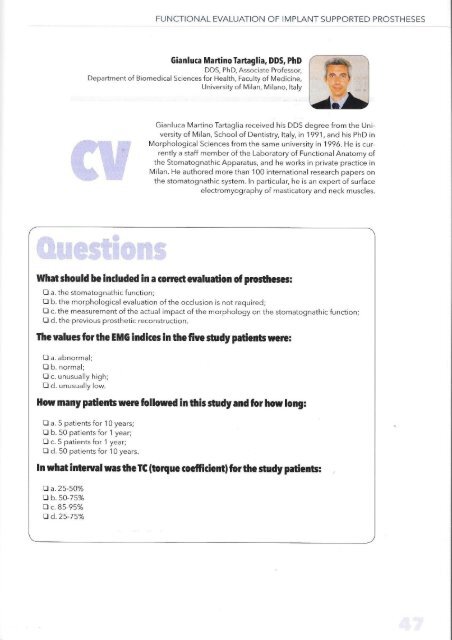STOMATOLOGY EDU JOURNAL 1-2014
You also want an ePaper? Increase the reach of your titles
YUMPU automatically turns print PDFs into web optimized ePapers that Google loves.
overdenture<br />
acrylic resin prostheses, with immediate load.<br />
These measurements can be well performed using<br />
surface EMG recordings of the main masticatory<br />
muscles, such as the temporalis anterior and<br />
the masseter (1,4,5,8). For instance, occlusal<br />
stability has been found to be related to muscular<br />
performance, significant associations may exist<br />
among dentition status, chewing ability, muscle<br />
strength and balance both in the young and the<br />
elderly po¬pulation (9,10)<br />
EMG allows not only to measure the electric<br />
potentials produced by the single masticatory<br />
muscles (values that are somehow related to the<br />
developed masticatory forces) (1,4,5,8), but it<br />
also allows the verification and quantification of<br />
muscular balance, between couples of muscles<br />
of the two sides of the body (symmetry), between<br />
couples of muscles with a possible later deviant<br />
effect on the mandible (torque) (1), and between<br />
couples of muscles with an action line positioned<br />
more forward or more backward to identify a<br />
hypothetic center of gravity of occlusion. Indeed,<br />
occlusion both on natural teeth and on prostheses<br />
with premature or sliding contacts can provoke a<br />
mandibular torque (4) or an unfavorable center of<br />
gravity. The consequent altered muscular activity is<br />
not macroscopically evident, but, in the mediumlong<br />
time, it could cause alterations in the bone.<br />
In the present study, patients with full-mouth<br />
prostheses on implants have been evaluated at<br />
the end of their prosthetic reconstructions and<br />
after one year with surface EMG.<br />
Methods<br />
Patients<br />
On September 2013, five male patients were<br />
selected from a dental practice in Milan during<br />
dental hygiene clinical recall appointments. These<br />
patients had received full mouth rehabilitation on<br />
4 implants (Milde® implants) in each dental arch<br />
from the same private practice between June 2012<br />
and September 2012. All the patients were in good<br />
health and edentulous in both arches. All of them<br />
have presented severe atrophy in the posterior<br />
regions of the arches. Clinical and radiographic<br />
diagnoses were performed, using preoperative<br />
panoramic radiographs and Cone Beam CT scans.<br />
All patients gave their informed consent to the<br />
immediate loading procedure. Immediately after<br />
the surgery (Fig 1), full-resin prosthesis with a resin<br />
CAD-CAM framework (Fig 2) was placed with distal<br />
cantilever extension – first molar area (12 teeth).<br />
To avoid the incidence of prosthetic<br />
complications, the neuromuscular equilibrium of<br />
occlusion in static conditions was evaluated in all<br />
patients with a surface EMG (TMJoint, BTS, Italy)<br />
of the masseter (MM) and temporalis anterior<br />
(TA) muscles of both sides (left and right) one<br />
week after the surgery. In all patients, dental<br />
Figure 1. Immediately post-operatory x-ray<br />
Figure 2. Digitized prosthetic CAM Framework<br />
contacts and vertical dimensions were adjusted<br />
to obtain normal values of the EMG standardized<br />
indices (see below). Articulating paper (Bausch,<br />
Germany) was used to morphologically finalize<br />
the occlusion and adjust it with respect to the<br />
functional parameters (Fig 3 a-b). Morphological<br />
occlusion consisted of central contacts on all the<br />
masticatory units. Dynamic occlusion consisted<br />
of group function guidance regardless of the<br />
opposite arch settings. This stereotyped occlusion<br />
was functionalized in each patient by means of<br />
the patient-specific neuromuscular response on<br />
rehabilitation. The EMG test was repeated during<br />
the recall appointment one year after the surgery<br />
(Fig 4).<br />
EMG analysis<br />
Details on the protocol have been reported by<br />
Ferrario et al. (1,4). In brief, four disposable bipolar<br />
surface electrodes (Duo-Trode; Myo-Tronics Inc.,<br />
Seattle, WA, USA) were positioned on the muscular<br />
bellies identified by palpation during a voluntary<br />
clench. EMG potentials were detected, amplified,<br />
digitized, digitally filtered and recorded using<br />
four of the six channels of the above mentioned<br />
computerized electromyography (1,2,4).<br />
During the test, all the patients sat with their head<br />
unsupported, the feet flat on the floor and the arms<br />
resting on the legs; they were asked to maintain<br />
a natural upright position. They performed both<br />
a standardization test and a 3 seconds maximum<br />
42 Stoma.eduJ (<strong>2014</strong>) 1 (1)



